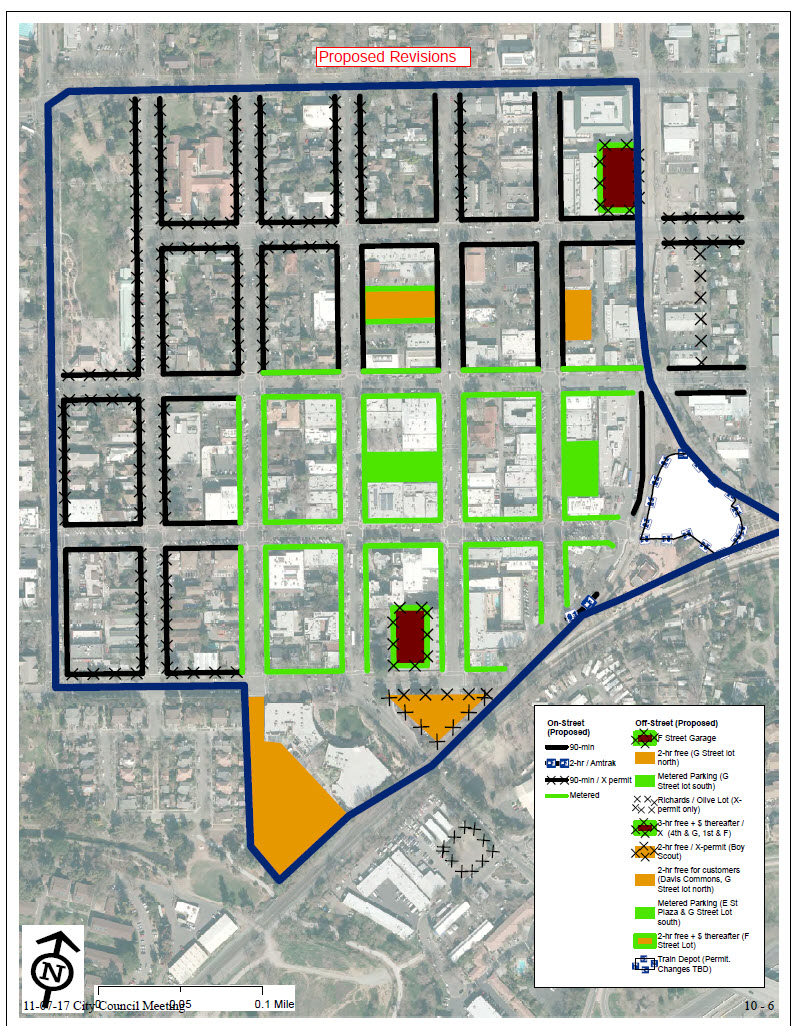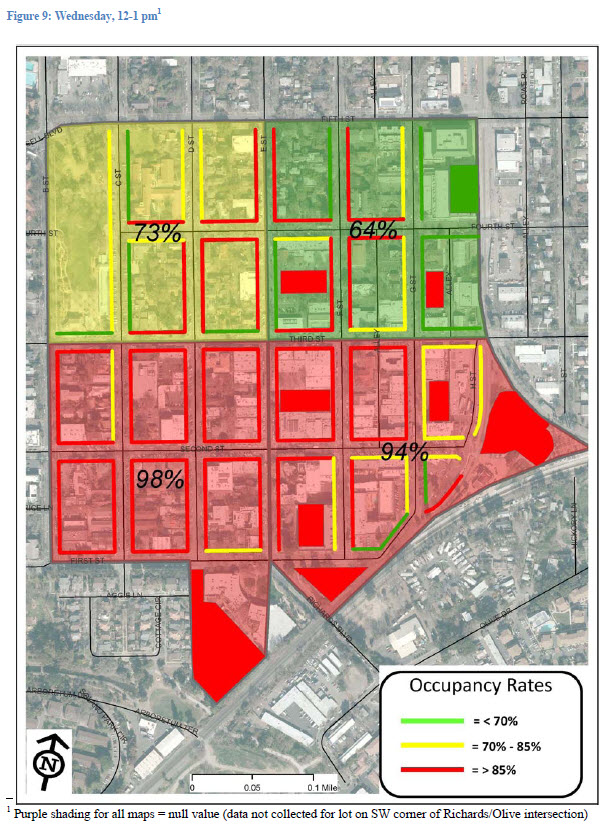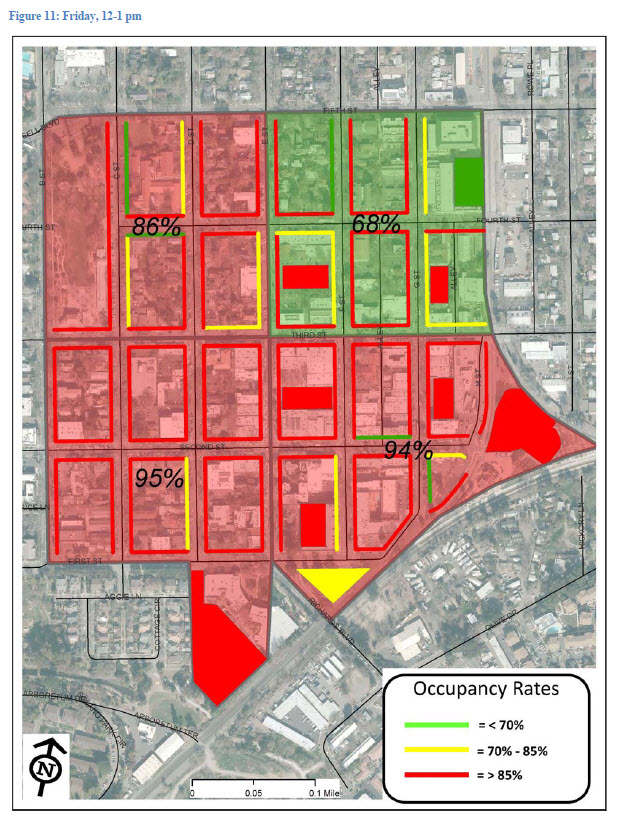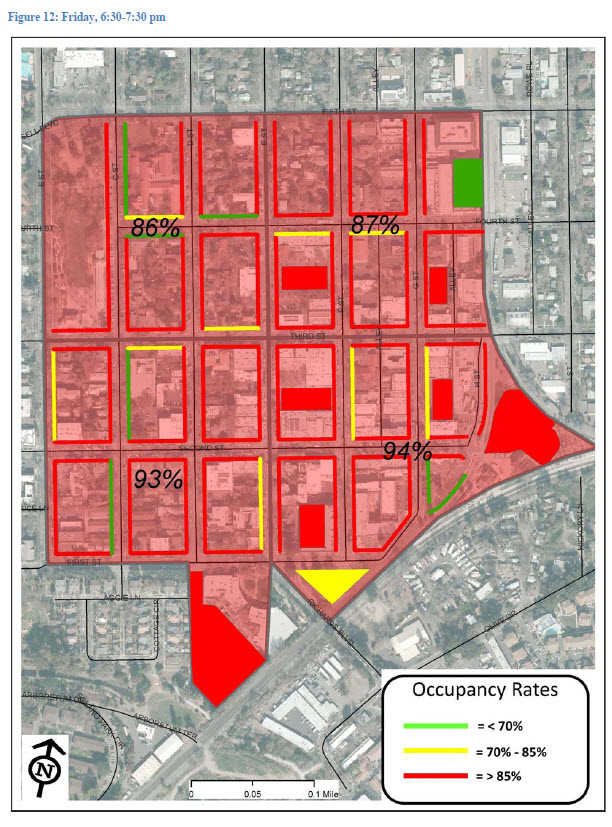

The council on Tuesday will be asked to address paid parking downtown, as a continuation of the process that began in 2012 with the Downtown Parking Task Force which issued the Spring 2014 Downtown Parking Management report. The 19 recommendations, some of which have been implemented, included a recommendation that “concluded that given downtown parking conditions, paid parking is a necessary tool for effective parking management.”
Staff believes that “applying paid parking in the southeast quadrant best balances the varied objectives for managing the downtown parking supply, best prioritizes users, while accommodating the needs of many user groups, and is operationally feasible.”
In April 2016, the city conducted a downtown parking occupancy rate survey. Both on-street parking and off-street public lots and garages were surveyed.
Staff writes, “Generally speaking, the ideal parking occupancy rate is in the vicinity of 85%. At this usage, the parking supply is being efficiently used while spaces remain available for new arrivals, preventing vehicles ‘circling’ downtown blocks in search of a parking space.”
They found that the average occupancy rate for the days and times collected was 70 percent, a slight decline from Fall 2015. However, downtown experiences parking peaks during the lunch and evening 
time frames.
Staff writes, “Downtown experiences parking ‘peaks’ during the lunch and evening timeframes. During these peaks, downtown parking closely reaches capacity resulting in vehicles circling around the block to find spaces, resulting in added congestion.”
Staff also notes, “The downtown parking supply can be split into two categories: on-street and off-street parking (i.e. public parking lots and garages). Customers typically prefer on-street parking as it is most convenient and therefore, the most impacted, particularly during the lunch and evening peaks.”
The survey found that in Spring 2016, on-street parking occupancy rates were 76 percent while garages were at 64 percent.

The survey found, “The Fourth & G structure continues to experience low occupancy rates for the publicly available spaces, with an average of 25%. In contrast, the First and F structure has an average occupancy rate of 71% with several peaks hovering near or above the 85% threshold.”
There is also variance by quadrant, with the highest demand for parking being located in the southeast quadrant, representing the heart of the downtown commercial district. The southeast quadrant has higher occupancy rates as that is where most of the X-permits are located and there are no underutilized surface parking lots.
Occupancy rates and zones also shift depending on time. For example, during the Wednesday 12 to 1 time slot, the southern portion of downtown, which has the majority of restaurants, is heavily impacted while the northern half is relatively unoccupied.

However, shift to a Wednesday evening, during Farmer’s Market, and you see the western part of downtown most impacted.

Fridays in general may be more impacted overall. Here we see Friday at lunch.

While a Friday evening is not going to have much in the way of available parking.

An explanation of staff thoughts in response to city council comments expressed at the August 9, 2017, meeting is as follows:
Limited Geography Pilot Program
“Staff does not recommend a small, limited geography pilot for on-street paid parking due to the five primary operational factors. A small scale is inefficient from a parking enforcement standpoint and Staff believes will result in parking behavior similar to what was experienced at the E Street Plaza lot upon its implementation: displacement of downtown employee parking impacts to adjacent block faces. Staff’s recommendation for a larger scale (i.e. southeast quadrant) is expected to more effectively mitigate displacement impacts by increasing downtown employee walking distances and reducing time-restrictions from two hours to ninety minutes on remaining block faces.”
Off-Street Lots
“The Staff recommendation maintains paid parking in the existing E Street Plaza lot, and introduces paid parking to the south G Street lot because they are both located within the southeast quadrant, where demand is highest. Remaining off-street lots would continue with two- or three-hour free parking with paid parking thereafter in selected lots and garages. Additional lots could be converted to paid parking at Council discretion. However, that would increase the percentage of total supply to which paid parking has been applied, conflicting with a limited geography objective and not consistent with overall demand.”
Consider Paid Parking on C, D, and E Streets
“The Staff recommendation to establish paid parking in the southeast quadrant includes D and E Streets between First and Third Streets. North of Third Street, parking occupancy rates are lower, even during peak periods. Based on peak parking occupancy data, a case can be made for applying paid parking to B and C Streets between First and Third Streets as well. However, high occupancy rates can partially be explained by on-street X Permit parking supply, which is where downtown employees are encouraged to park. Layering paid parking over X-Permit parking could be considered on C Street, but this would also conflict with a limited geography objective.”
At this time, the council is being asked to approve proposed revisions for expansion of paid parking and time-restricted parking. Staff would then return to council at a future date with ordinances, resolutions, and contracts implementing revisions.
—David M. Greenwald reporting


So as outlined by city staff the problem is only during the lunch and dinner peak times so therefor the plan should be to only administer parking fees at those times.
I wonder how practical that is. My thought would be paid parking on F and G south of third.
OK… my view is C to J, Fifth to First/Second. I’d support that…
As resident of 30 + years of both car dependent North Davis, and car independent OED, I am in support of paid parking in general. Agnostic about hours included.
We have a pilot project in downtown, it is the E St Plaza Parking Lot and it is always around 85% or more capacity.
I just took this shot with every space taken a several cars looking. So the paid parking is not a deterrent. People can pick between paid and free parking and still choose paid.
Second St. Parkingaza is a cancer in the heart of Downtown. We can see its true importance when it’s closed to motor vehicles and used instead for public events be-fitting a proper town center in a civilized Western country.
If 4th and G was utilized as is 1st and F, and more parking is shifted east and north a bit, Second St could be a real plaza or town square, open for activities and the place to meet. In the center of things. Central Park is not central. It’s great during Farmer’s Market and certain large activities, but has a large dead area under the roof all the other times.
85% is a good goal, but the problem is the overall location of parking. This is supposedly a town that prioritizes cycling (and walking). If this is NOT what people really want, then get rid of the branding using the anti-egalitarian anachronistic pennyfarthing. This new plan will help and thanks! to all who are pushing it forward, but I fear it will not make enough of a difference for parents who will not let their children cycle Downtown in the “cycling capitol” of the USA!
I am all for access; I want Downtown to do well. Businesses fortunate enough to be on a real plaza on Second St. will do much better if they front on a pleasant, sweet-smelling area. ALL Downtowns, town centres, and shopping districts which become pedestrianized T-H-R-I-V-E, as long as they have good access by all modes, BUT not at the expense of other modes.. A-C-C-E-S-S. M-O-N-E-Y. W-E-A-L-T-H.
But there is NO integrated access plan for Downtown. This has to be a key part of the Downtown Core Area discussion.